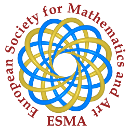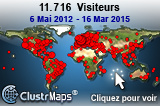First ESMA Conference
Date: JULY 19-22, 2010
Location: Institut Henri Poincaré,
11, Rue Pierre et Marie Curie 75231 PARIS
Amphithéâtre Hermite
URL: http://www.math-art.eu
Description:
Contributions to the Conference will belong to one of the four sections : 1) Static works (paintings, sculpture, architecture) 2) Cinematic works (videos, films, installations) 3) Tool in math art (softwares, 3D printers) 4) Education, history and philosophy in and through Math Art.
Scientific and Artistic Committe :
François Apéry (Mulhouse), Luc Bénard (Montréal), Claude Bruter (Paris), Jean Constant (Santa Fe), Michele Emmer (Rome), Michael Field (Houston), Dmitri Kozlov (Moscou), Jos Leys (Anvers), Konrad Polthier (Berlin), John Sullivan (Berlin).
Program:
LUNDI- MONDAY 19
| 09.00-9.15 | VILLANI-BRUTER | |
| 09.15-09.40 | Claude BRUTER | An Introduction to the Construction of some Mathematical Object |
| 09.45-10.15 | Mike FIELD | Symmetry, Chaos and Design using mathematics in art |
| 10.30-11.15 | Dmitri KOZLOV | Knots and links as form-generating structures |
| 11.30-12.00 | Andreas MATT | Math-Art in Science Communication - experiences from the traveling exhibition IMAGINARY by the Mathematisches Forschungsinstitut Oberwolfach |
| 14.30-15.00 | Konrad POLTHIER | Images of Mathematics - a mathematical picture book |
| 15.15-16.45 | Dough DUNHAM | M.C. Escher's Use of the Poincaré Models of Hyperbolic Geometry |
| 16.00-16.30 | Christian MERCAT | Anamorphoses à travers une webcam |
| 16.45-17.15 | Jos LEYS Aurélien ALVAREZ |
Dimensions, a math movie |
TUESDAY-MARDI 20
| 9.00-9.30 | Dick PALAIS | A Mathematician and an Artist. The Story of a Collaboration |
| 9.45-10.15 | Jean CONSTANT | Structure of visualization and symmetry in iterated functions |
| 10.30-11.15 | Simon SALAMON | Dynamic Surfaces |
| 11.30-12.00 | John SULLIVAN | Pleasing Shapes for Topological Objects |
| 14.30-15.00 | Antonia REDONDO-BUITRAGO Encarnación REYES-IGLESIAS |
Geometry and Art from the Cordovan Proportion |
| 15.15-15.45 | François TARD | Rhombopolyclonic Polygonal Rosettes Theory |
| 16.00-16.30 | Luciano BOI | Nœud, trous et espaces : sur les analogies profondes entre topologie et art |
| 16.30-17.15 | Eugenia EMETS | Visualising sublime: intuitive approach to geometric constructions |
WEDNESDAY-MERCREDI 21
| 9.45-10.15 | Richard DENNER |
Polyhedral eversions of the sphere; gastrulation |
| 10.30-11.15 | François APÉRY | OLD AND NEW MATHEMATICAL MODELS: SAVING THE HERITAGE OF THE INSTITUT HENRI POINCARE |
| 10.30-12.00 | George HART | Mathematical Sculpture and The Museum of Mathematics |
| 14.30-14.45 15.00-15.45 |
ESMA MEETING | |
| 16.00-16.30 | Vi HART | Mixing Mathematics with Music Boxes |
| 16.45-17.15 | Tom JOHNSON | Mathematical Music: Examples from recent score |
THURSDAY-JEUDI 22
| 09.00-09.30 | Hervé LEHNING | Art and the popularization of Mathematics |
| 09.45-10.15 | 15 Philippe RIPS | Du polyèdre au nœud de trèfle |
| 10.30-11.00 | Patrice JEENER | My Mathematical Engravings | 11.15-12.00 | Jean-François COLONNA | Mathématiques, Physique, et Art |
Proceedings
Published by Springer under the title :Mathematics and Modern Art the book appears as the following:Preface
The first Conference of the European Society for Mathematics and the Arts (ESMA) was held at the Henri Poincaré Institute in Paris from 19 July to 22 July 2010, and was accompanied by an exhibition qt the same Institute (see http://mathart.eu/ihp10/index.html). This volume gathers together the texts of the majority of talks held during the conference.
A large proportion of the public may still question whether one can closely link mathematics and art. In fact, that link, implicit or explicit, was established with the first creations of decorative and re- ligious art. Great painters, whose imagination and creativity also had a rational basis, found the structural foundations of their art inside the mathematics to whose development they sometimes contributed.
The remarkable course of the symbolic sciences in the last hundred and fifty years and what it has revealed have provided us an inkling of the diversity of forms that can populate spaces, and above all ours. Because it is not bound with numbers, this diversity is infinite.
These forms, mostly unexpected and often very beautiful, cannot help but arouse the curiosity of mathematicians and artists alike. By making these forms known through their work – which allows them to reach the peoples of all countries – artists contribute in a subtle way to making everyone familiar with this wonderful and plentiful universe of new objects. As such, they make an essential contribution to breaking down the psychological barriers that still separate mathematics from some sectors of society.
In each of the chapters of this work, readers will discover works of art whose main characteristic is that they have been created by the computer brush on the canvas of mathematical rationality. The text can be interpreted as an invitation to an initial exploration of some aspects of the mathematical world, namely those that are inherent in
2
each work: some aspects only, as there are so many different possible approaches to the universe of these abstract physics. One can for example gain access to the practice of number theory, analysis, and algebra. Even if, when reading the book, these main fields of mathematics seem at first blush to be of little benefit to geometry, in truth they have contributed greatly to enhancing the role enjoyed by geometry in its broadest sense, used to describe not only the static and inanimate but also movement and the animate.
The emphasis placed on geometry is justified by the fact that it treats both the exterior and the interior forms of objects. Some of these forms are very familiar to us, associated with physical or biological objects created by nature long ago, or even more recently by man himself. One can observe the particularly strong presence of pure mathematical forms in artifacts of the latter type, whether it be the table (square, rectangular, circular, elliptic), the cubic pedestal, parallelepiped furniture, the pyramid on a square base, or the most recent roofing technologies to shelter opera houses. The forms are in a sense the incarnation of geometry in the physical world. Conversely, we could say that geometry is an incarnation of the physical world in the symbolic world. As such, it is fitting that many articles in this work show where these two types of incarnation appear.
First readers of this book will no doubt be mathematicians and artists. The former will most likely explore the work out of intellectual and aesthetic interest, and to better imprint their minds with the reality and knowledge of objects that they have already encountered, or even contributed to creating. But the same concern for curiosity and interest will surely motivate many artists. Insofar as the contributing authors reveal their methods and the techniques they advocate, the articles should be capable of giving stimulus to all those who would like to acquaint themselves with these modern forms of art before penetrating further.
Humanity is following and evolutionary path that should allow it, by transforming itself, to ensure its permanence before the solar fire burns our Earth. The disembodied symbolic forms that we have con-
3
structed and that we continue to create naturally escape igneous destruction. The replacement of the oil painting and the brush by the computer, of the coloured powder by the number, of the physical motif in our environment by the symbolic motif discovered and simultaneously created by the mathematician, fits suitably into this evolution. This volume provides the evidence for a scientific and artistic movement destined to assimilate such rich developments.
Claude Paul BRUTER
Table of Contents
A Mathematician and an Artist. The Story of a Collaboration
Richard PALAIS
Dimensions, a Math Movie
Aurélien ALVAREZ - Jos LEYS
OLD AND NEW MATHEMATICAL MODELS: SAVING THE HERITAGE OF THE INSTITUT HENRI POINCARE
Jean-François APÉRY
An Introduction to the Construction of some Mathematical Object
Claude P. BRUTER
Structure of Visualization and Symmetry in iterated Function Systems
Jean CONSTANT
M.C. Escher's Use of the Poincaré Models of Hyperbolic Geometry
Dough DUNHAM
Mathematics and Music Boxes
Vi HART
Mes Gravures Mathématiques
Patrice JEENER
Knots and Links As Form-Generating Structures
Dmitri KOZLOV
Geometry and Art from the Cordovan Proportion
REDONDO-BUITRAGO -
Dynamic Surfaces
Simon SALAMON
Pleasing Shapes for Topological Objects
John SULLIVAN
Rhombopolyclonic Polygonal Rosettes Theory
François TARD
INDEX
[A-L] Alvarez-Leys, [AP] Apéry, [BR] Bruter, [COL] Colonna, [CO] Constant, [DU] Dunham, [HA] Hart, [JE] Jeener, [KO] Kozlov, [PA] Palais, [R-R] Redondo-Reyes, [SA] Salamon, [SU] Sullivan, [TA] Tard
| Attachment | [BR] |
| Atractor Lorenz- | [SA] |
| Blowing-up | [BR] |
| Boy surface 3-symmetry 5-symmetry Wire-model- | [AP][JE] [JE] [JE] [AP] |
| Cordovan
Proportion Polygon- | [R-R] [R-R] |
| Coil Turn of- | [KO] |
| Curvature of a curve Gauss- Geodesic Mean- | [JE][KO][SA][SU] [SA] [JE] [KO] [SU] [AP] [SU] |
| Cutting | [BR] |
| Cyclids One sided- Dupin - Ring parabolic | [AP][PA] [AP] [A-L][AP] [AP] |
| Dandelin model | [AP][JE] |
| Dini helicoid | [JE] |
| Dodecahedron Poinsot great- | [AP] |
| Eversion Sphere- | [SU] |
| Folding | [BR] |
| Four-dim polytope | [A- L] [SU] |
| Fractal | [A-L][PA][SA] |
| Functions bi-periodic Jacobi- Weierstrass- | [JE] [JE] [JE] |
| Genus | [KO] |
| Hyperbolic geometry- plane Surface- | [PA] [DU] [DU] [JE][PA] |
| Identification | [BR] |
| Illusion Aitken wheel- Ebbinghaus Hering- Hermann grid- Wundt- | [CO] [CO] [CO] [CO] [CO] |
| Inflation Regular- Singular- | [BR] [BR] [BR] |
| Isoperimetric problem | [SU] |
| Isoperimetric rhombus | [TA] |
| Jacobi functions | [JE] |
| Klein Bottle Double - Triple - | [AP][JE] [JE] [JE] |
| Knot Borromean link- Cyclic- Trefoil- True-lover- Turk's head- | [KO] [SU] [SU] [KO] [KO] [SU] [SU] [KO] [SU] |
| Kuen surface | [JE][PA] |
| Minimal surface Bonnet - Catalan- Enneper- Henneberg- Jeener- | [JE] [JE] [JE] [JE] [JE] [JE] |
| Möbius band | [AP][JE][BR] [HA][KO][SA] |
| Monge formula | [JE] |
| Morin surface wire model- | [AP][JE] [SU] [AP] |
| Nodus | [KO] |
| Petal loop | [KO] |
| Pinching | [BR] |
| Poincaré disk model half plane model | [DU] [DU] |
| Pseudo-sphere | [JE][PA] |
| Rhomboic polygon | [TA] |
| Rosette | [TA] |
| Sierpinsky carpet | [CO] |
| Sievert Surface | [AP][JE] |
| Singularity antibubbling- bubbling- fractal- | [BR] [BR] [BR] [BR] |
| Smooth cubic | [AP] |
| Software Conversational Multimedia System Evolver Pixar's RenderMan Power-Ray 3D-XplorMath | [COL] [SU] [SU] [A-L] [PA] |
| Soliton | [PA] |
| Thickening | [BR] |
| Topology | [SU] |
| Torsion of a curve null-torsion-surface | [SA] [SA] |
| Vector-field | [SA] |
| Weiestrass Formula- P-Functions- | [JE] [JE] [JE] |
| Willmore energy | [SU] |


&pg-0082(300PPP).png)


.png)
